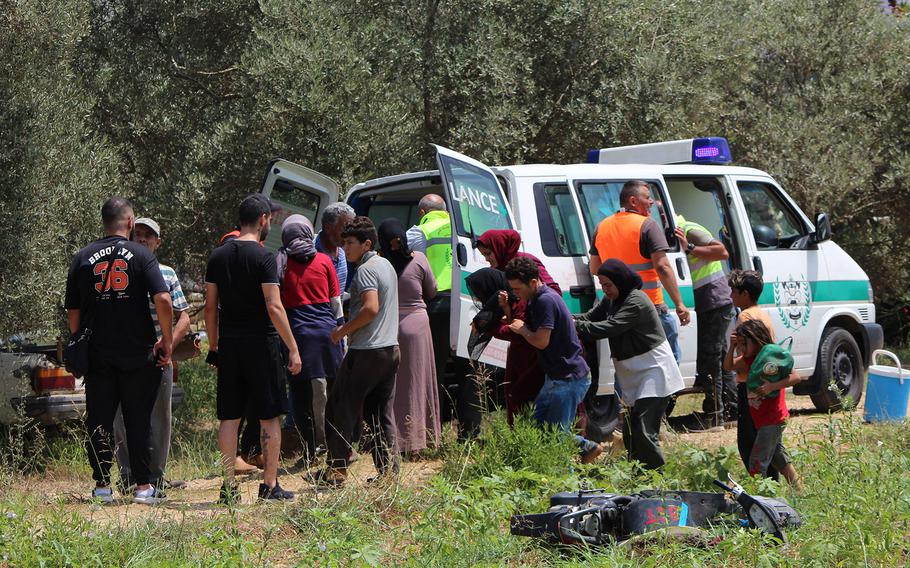
Rescuers evacuate injured Syrians living in makeshift tents in Lebanon, after the Israeli military targeted the area near the village of Burj al-Muluk, some 11 miles from the town of Nabatiyeh on July 20, 2024. (Rabih Daher/AFP/Getty Images/TNS)
(Tribune News Service) — When the Hezbollah militant group began trading rocket fire with Israel in October, Zoe Sages and her family left their home near the Lebanese border and decamped to a hotel further south.
More than nine months later, they and hundreds of other members of the Sasa kibbutz are still there, striving to maintain their communal way of life and children’s schooling. While the government pays for their food and accommodation, the pressures of living in a 320-square-foot room in the sweltering town of Tiberias on the Sea of Galilee are taking their toll.
“The community wants to return home 100%,” said Sages, 36, a human-resources director and mother of three who moved to Israel from the UK in 2006. “The questions would be under what conditions and whether normality will return.”
Sages is one of hundreds of thousands of people in Israel, Lebanon and the Palestinian territory of Gaza whose lives have been upended since Hamas-led militants invaded southern Israel on Oct. 7, killing about 1,200 people. Israel’s retaliatory and ongoing air and ground assault has claimed more than 38,000 lives in Gaza, according to health officials in the Hamas-run territory.
Lebanon-based Hezbollah opened fire in solidarity with Hamas, launching drones, rockets and missiles at towns and villages across northern Israel. The Israeli military has responded with hundreds of strikes of its own, and communities on both sides of the border have fled.
Domestic pressure on Israeli Prime Minister Benjamin Netanyahu to enable evacuees to return home has raised the prospect of an all-out conflict, which could devastate both countries.
Israel and Hezbollah last fought a war in 2006 that lasted 34 days and wrecked parts of Lebanon. The militant group has since accumulated a vast arsenal of rockets that are capable of reaching every corner of Israel.
Both Hamas and Hezbollah are backed by Iran and designated as terrorist groups by the U.S.
Within Israel, about 143,000 people had evacuated their homes or were eligible to do so by late June, 68,500 of whom were from the north near Lebanon and 74,500 from the south, according to a report from the Knesset Research and Information Center. The number of people housed in hotels fell to 22,800 by the end of June, down from a peak of about 50,000, as evacuees made alternate accommodation plans or braved the violence and returned home.
It costs the state about $137 a night to house an adult and half that for each child. The subsidization program has thrown a lifeline to the hotel industry, which has been among the hardest hit by the war as scores of incoming flights were canceled and international visitors stayed away. Even so, the Israel Hotel Association says about 10% of the 450 establishments owned by its members have shut or are in danger of doing so, with tourism likely to recover by 2026 at the earliest.
In Lebanon, about 93,000 people have been displaced and the bulk of them are being sheltered by family or forced to fend for themselves because the government can’t afford to provide support. The nation’s economy has been in crisis since about 2020, when a banking and government-debt emergency wiped out people’s savings and pushed three-quarters of the population into poverty.
The plight of the displaced is at its worst in Gaza. Many Palestinian families have been uprooted multiple times as the Israeli campaign moved south and laid waste to much of the territory.
About 90% of the 2.1 million people in the densely populated strip have fled their homes and lack access to sufficient shelter, food, medical services and clean water, according to the United Nations. It estimates that more than 70% of homes have been damaged or destroyed in the fighting.
The fighting in Gaza has shown signs of slowing down, with Israel reporting significant headway in eliminating Hamas leaders and its extensive tunnel network. Yet on Monday, the military ordered civilians to leave parts of the city of Khan Younis once again to make way for a fresh assault.
Said Al-Ashi, 19, is one of the displaced. A medical student, he left Gaza City in the north along with his sister, mother and grandmother when Israel first attacked.
They took shelter with a relative in Khan Younis before moving to the southern-most town of Rafah, near the Egyptian border. They have since relocated to a tent at Al-Mawasi, a sandy coastal expanse with hardly any infrastructure that’s now home to hundreds of thousands of uprooted people.
“Instead of spending my time studying, preparing for classes and meeting new friends at the university, my time is lost on water queues, collecting plastic and dry branches to make a fire, or fleeing the bombardment,” Al-Ashi, who is now trying to secure a bursary to continue his studies outside of Gaza, said by phone.
With assistance from Fares Akram, Galit Altstein and Gina Turner.
©2024 Bloomberg L.P.
Visit bloomberg.com.
Distributed by Tribune Content Agency, LLC.